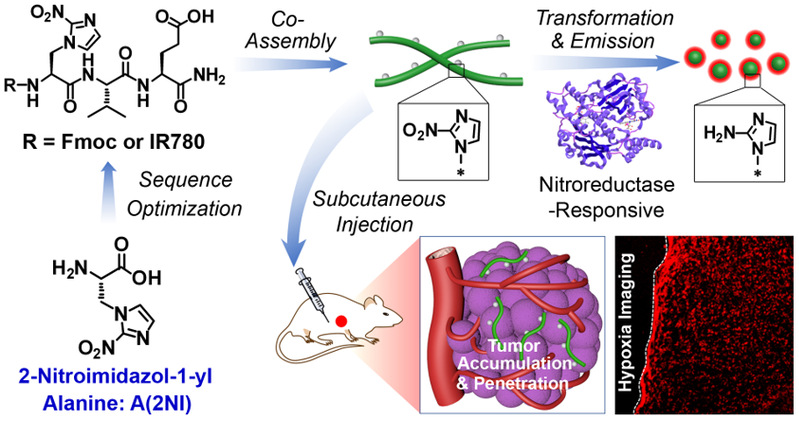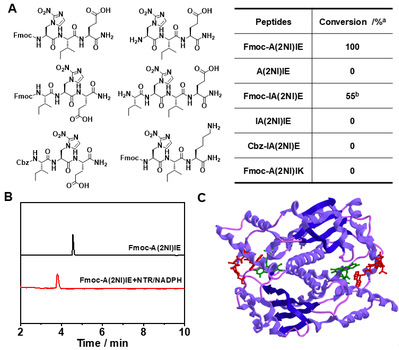Zhilin Yu’s Group JACS: Noncanonical Amino Acids for Hypoxia-Responsive Peptide Self-Assembly and Fluorescence
Malignant tumors, one great threat to human health, tend to be hypoxic. With hypoxia progression, effectiveness of chemotherapy and radiotherapy for malignant tumors will be greatly reduced. Nitroreductase (NTR) conventionally overexpresses in the hypoxic region of solid tumors, thus it’s highly meaningful developing NTR-responsive nanostructure in detection and treatment of solid tumors. Research fellow Zhilin Yu’s group reported a noncanonical NTR-responsive amino acid that regulates self-assembly of peptides through NTR reduction and activates fluorescent nanostructures, thus allowing for efficient fluorescence imaging of solid tumors in hypoxic regions. Reduction of nitro groups into amino groups allows for morphological transition of nanofibers into nanoparticles, preventing fluorescence quenching caused by nitroimidazole. With morphological transition of peptides nanostructures as well as fluorescence restoration, the synthesized supramolecular fluorescent probes work on efficient hypoxia imaging. The study has been published in J. Am. Chem. Soc. (Noncanonical Amino Acids for Hypoxia-Responsive Peptide Self-Assembly and Fluorescence, DOI: 10.1021/jacs.1c06435)

Controlled assembly of peptides and fluorescence imaging of tumors based
on 2-nitroimidazole-alanine (A(2NI)). Image credit: J. Am. Chem. Soc.
Structural features of peptide nanostructures rely on amino acid sequences. The sequences are changed via stimuli-responsive reaction, precisely modulating peptide assembly in a controlled way. Based on previous researches (Nano Today 2021, 38, 101198;Chemical Science 2020, 11, 1383;Nano Letters 2019, 19, 7965), with reduction response characteristics of natural histidine and nitroimidazole moieties, Zhilin Yu’s group synthesized a new amino acid 2-nitroimidazol-1-yl alanine via Mitsunobu reaction. The tailored peptide sequences achieve NTR-response. Research results suggest the N-terminal Fmoc group and the C-terminal negative glutamic acid of peptides are the critical structural features for NTR-response. Morphological transition of peptide nanostructures by nitro-reduction is achieved through optimizing peptide hydrophobicity.

Figure 1. Nitroreductase responsiveness of A(2NI) containing polypeptide molecules.
Since 2-nitroimidazole serves as fluorescence quencher for many fluorophores, researchers attached dye IR780 to the peptides and synthesized a hypoxia-responsive supramolecular fluorescent probe. Owing to NTR-optimized morphological transition and the recovered fluorescence, the probe performs excellent tumor accumulation and penetration in the in vivo study, achieving efficient hypoxia tumor imaging. The noncanonical amino acid is promised on optimizing the behavior of peptides and proteins in hypoxic regions, thus expanding to preparation and development for biomedical materials.

Figure 2. Imaging results of cells and living solid tumors under hypoxic conditions
by supramolecular nanoprobes. Image credit: J. Am. Chem. Soc.
The research was supported by the National Natural Science Foundation of China and the Fundamental Research Funds for the Central Universities. Doctoral student Binbin Hu, Nankai University, is the first author; research fellow Zhilin Yu, College of Chemistry, Nankai University, is the corresponding author.
Online Link: https://pubs.acs.org/doi/10.1021/jacs.1c06435

